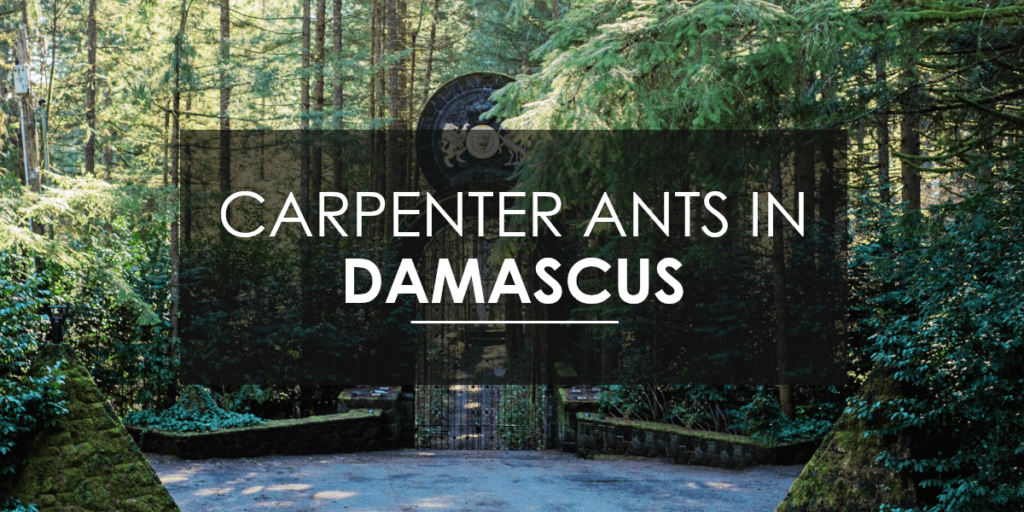Carpenter ants in your home or business? That doesn’t sound good, does it? We agree! And that’s why we’ve helped hundreds and thousands of folks over the years rid their homes and businesses of carpenter ants and other pests that cause burden on your peace of mind.
At Aspen Pest Control, we work closely with our clients in order to effectively answer the questions: What exactly are carpenter ants? Why do I have a carpenter ant infestation? How do I get rid of carpenter ants? and How do I prevent the carpenter ants from coming back?
What are carpenter ants?
Carpenter ants! Just the mention of them is enough to cause concern. As pest control experts, we at Aspen Pest Control absolutely agree, but not exactly for the reasons you might suppose.
You see, carpenter ants are often confused with termites. Termites and carpenter ants, however, are distinctly different creatures. Termites consume wood. Carpenter ants, on the other hand, burrow through wood. Carpenter ants are not capable of digesting cellulose (plant fibers) and are actually predatory in nature. Carpenter ants will consume what is called “insect honeydew,” a secretion that comes from aphids and other insects, as well as the juice of plants and fruit, and small insects.
Amongst over 1,000 different species found across the globe, the carpenter ant we most often see in North America (and most specifically, in the greater Portland area) is called the black carpenter ant.
What do carpenter ants look like?
Upon first glance, carpenter ants look a lot like most other ants. However, there are distinctions, mainly in regards to size. These black and red-hued ants typically measure to about one-half inch in length, with colonies that consist of four basic inhabitants: queens, larvae, males, and workers.
Once they’ve established nesting sites for the colony, they often create incredibly elaborate tunnel systems, usually connecting smaller nests that will ultimately lead the colony’s primary nesting site. The most common places to find a carpenter ant nesting site is in dead trees or in other spaces made of wood. These ants are not choosy, and will happily build out its colony in the wood of homes or in commercial buildings. Each type of ant in the colony has a special role that it fulfills.
What does each type of carpenter ant do?
In a nutshell, carpenter ants exist only to grow and expand their colony. The worker ants, as is the case with many other types of insects, have a wide range of responsibilities, including the building and the ongoing maintenance of the nesting sites, as well as the gathering, storage, and distribution of food for the colony. Though they perform many tasks, they do so based on pheromones (chemical signals) that are communicated to them by the queen.
The male carpenter ant exists for one sole purpose: to mate with the queens so that they may lay eggs and grow the footprint of the colony. They will die shortly after fulfilling their duty.
Queens, of course, exist to lay eggs, grow the colony, and to provide direction to the worker ants and males. Because carpenter ant colonies can have multiple queens, and because queens are protective of their nests, they can be territorial — even aggressive — with other colony inhabitants if they feel proper respect isn’t being given to their nesting site.
Do you suspect that you have a carpenter ant infestation?
Think you have carpenter ants? There are some tell-tale signs if you do. Let’s take a closer look. When looking at the wood where you think the infestation is occurring, what does it look like? Is it covered with a series of small holes, or does it appear to be splintered? Are the holes or splinters coinciding with what looks like a very fine sawdust? If you were to say yes to these questions, then you just might be experiencing a carpenter ant problem in your home or business. To be certain, we recommend you work with a professional pest extermination team.
The longer you wait to address this concern, the greater opportunity for the colony to grow, and for the colony to cause additional damage to the nesting site. Given enough time, carpenter ants can be just as destructive as termites if left untreated. Time is of the essence.
How did I get a carpenter ant infestation?
As is the case with many pests, carpenter ants are attracted to moisture. As you can imagine, this makes Portland and the Pacific Northwest a very active area for carpenter ants to thrive in. Because of this, Aspen Pest Control recommends that any home or business owner should give particular attention to potential rot, water damage, and other areas susceptible to breakdown in and out of the home. When this type of damage occurs, it essentially creates a means for pests to enter the structure and cause further damage throughout.
Where does water naturally drain outside your home? Have you recently inspected your eaves? Cleaned clogged gutters? Have you checked where plumbing enters the home and the areas where water leakage can occur inside the home, like under sinks, in laundry rooms, in bathrooms, or other areas that are plumbed? These areas are susceptible to carpenter ants and other pests and should be periodically examined.
Double-check to make sure you’re dealing with carpenter ants!
Remember how we said that carpenter ants often have several small colonies that are a part of a larger one? Well, if you find that you have carpenter ants in your home, we’ve frequently found that this is likely a smaller colony connected to a larger one that is outside your home. If you’re working with professionals, make sure that they’re looking for the main colony and that they’re doing a thorough job. And, of course, make sure that they’re treating the right pests.
Going back to the carpenter ant vs termite comparison: When you’re looking at the pathways these creatures have created (called “galleries” in both instances), what do they look like? Are they smooth and clean? Is there sawdust or even dead insects outside of the entry points? If this is the case, then you’re probably dealing with carpenter ants. But if the galleries are dirty in appearance, muddy or sandy, then you’ve probably got some termites on your hands.
Additionally, termites are incredibly destructive, both structurally and financially, to the tune of over $5 billion annually. Carpenter ants, on the other hand, do damage that is largely cosmetic and far less costly. But it is still damage to the structure nonetheless and has the ability to compound over time. A carpenter ant infestation should not be ignored.
So what is the most important step you can take? Call a team of experienced professionals!
How do I get rid of a carpenter ant infestation?
Are there DIY methods for treating carpenter ants? Yes! Do we believe that off-the-shelf methods are as effective as commercial grade products? We do not. In fact, they only superficially treat your ant infestation.
Repellent sprays are effective in exterminating the worker ants that you can see, but they are not effective in delivering the exterminant to the heart of the colony, and therefore will not get to the root of the issue as they are unable to consistently kill the queens or the larvae. In order to truly rid your home or property of pests, you need an expert by your side.
Should you choose Aspen Pest Control for your carpenter ant extermination needs, we’ll not only give you a hassle-free recommendation and trustworthy recommendations for ongoing maintenance, but we’ll really, really listen to your needs. Pest control, to us at Aspen, is all about showing the value of our services by doing the best job possible for you. We Inspect all areas as thoroughly as possible. We apply the right combination of extermination products at the right frequency. And, over time, we observe your trouble areas for potential reapplication of products to prevent a future infestation.
Carpenter ants are not dangerous creatures. They will not bite you or hurt you. But they cause significant damage to your home or to other structures on your property if left untreated. Wouldn’t you rest so much easier knowing their presence was a thing of the past?
Call Aspen Pest Control today for your free consultation!






